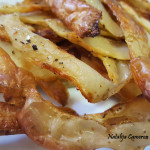I don’t normally buy quince. This week, however, I received a few as a gift. I was delighted! And it didn’t take me very long to decide what to do with them: make quince konfyt (preserve). As the days get colder and colder, I seem to yearn for comfort foods and the lovely aroma of quince konfyt brings on just the comfort to me! Pale and hard while raw though, quince will soften as it cooks and develop its distinctive taste and soft texture by the time the konfyt is done.
Quince usually ripens in autumn so this is the right time to look for them in the shops or at the greengrocer’s. Quince is also wonderful as a room freshener. I used mine the same day but if you’re planning to have them sit for a couple of days before you use them, you might as well leave them on a plate on your dining room table or a side table in the living room. After a couple of hours the room will simply take on the aroma of this delightful fruit. The good thing is that this will not affect the taste once the fruit is cooked.
Here are the ingredients I used to make quince konfyt (preserve) and how much they cost:
900 gr. Sugar = R 9.70
6 Quince = Gift, but it costs about R 19.00 per kg in the shops
2 hours stove plate Electricity = R 7.60
A few whole cloves
This yielded 2 jars, or 900 gr. of delicious quince konfyt at the cost of R 17.30 (or R 36.30, had I bought the quince myself). I’m not quite sure what the price of quince konfyt is at the shops or at a market nowadays as I haven’t seen any for quite some time now. All things considered, though, I think the amount of konfyt that we got was quite good value for money and it will last us quite a while.
So here is how to make this delicious quince konfyt at home. Wash and peel the fruit, and remove the pips. Cube the fruit. I prefer to cut quince to roughly 1cm cubes. Place fruit into a pot and cover just enough with hot water. Bring it to the boil then reduce heat while still allowing the fruit to boil gently for at least another 20 minutes. Then add the sugar and the cloves and simmer for about an hour. Adding a few whole cloves gives the konfyt its bit of warmth.
To test whether or not the konfyt is ready, drop half a teaspoon of syrup into a glass of ice cold water and see if it sticks together very, very loosely – you don’t want it too runny and you don’t want it to be too sticky either. It’s essential that you keep checking the consistency as well as the colour of the konfyt which should be a darker shade of orange but not too dark (if this happens it means that the syrup has cooked for far too long and is now caramelised). When ready, pour the quince konfyt into sterilised jars when ready, close the lid and leave to cool down to room temperature before refrigerating.
Quince konfyt is delicious on toast but also added to a steaming hot bowl of oats on a cold winter’s day or on pancakes. Enjoy!












